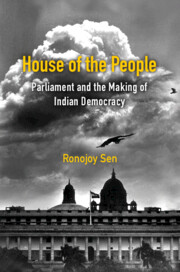Book contents
- Frontmatter
- Dedication
- Contents
- List of Illustrations
- Acknowledgements
- Introduction
- 1 The Road to Parliamentary Democracy: The Constituent Assembly and Its Prehistory
- 2 Protean Institution: The Changing Composition of Parliament
- 3 ‘Please Take Your Seat!’ Disruptions in Parliament
- 4 Inside Out: The Parliamentary Committee System
- 5 Corruption, Criminality and Immunity
- Conclusion
- Index
Introduction
Published online by Cambridge University Press: 11 October 2022
- Frontmatter
- Dedication
- Contents
- List of Illustrations
- Acknowledgements
- Introduction
- 1 The Road to Parliamentary Democracy: The Constituent Assembly and Its Prehistory
- 2 Protean Institution: The Changing Composition of Parliament
- 3 ‘Please Take Your Seat!’ Disruptions in Parliament
- 4 Inside Out: The Parliamentary Committee System
- 5 Corruption, Criminality and Immunity
- Conclusion
- Index
Summary
Though it was not a given, the odds would have been stacked in favour of India adopting the British parliamentary model when it became independent in 1947. There is a nice little story about how deep rooted the notions of Westminster-style parliamentary democracy were in India. When a future British prime minister, Clement Attlee, was visiting India as part of a commission in the 1930s and argued for a presidential system, he found no response. Attlee later recalled, ‘It was as if I had offered them margarine instead of butter.’ There were other voices, admittedly in the minority, who believed that India should look to indigenous models. One member of India's Constituent Assembly called the Indian Constitution a ‘slavish surrender to the West’; another more eloquently proclaimed, ‘We wanted the music of Veena or Sitar, but here we have the music of an English band.’ Eventually what the Constituent Assembly adopted was very much the British parliamentary system based on first-past-the-post elections with two houses of parliament: the Lok Sabha (House of the People), or the directly elected lower house, and the Rajya Sabha (Council of States), or the indirectly elected upper house.
The Indian parliament has come a long way from when India's first prime minister Jawaharlal Nehru gave his memorable ‘Freedom at Midnight’ speech in 1947 in the Central Hall to the scenes in 2008 when three members of parliament waved wads of cash inside the House during a no-trust vote claiming that they had been bribed to vote for the government. In its early days, the Indian parliament was held up as an example for the rest of the newly independent countries. In 1952, shortly after the first Indian general elections, the Manchester Guardian commented: ‘Parliamentary institutions have not had a very good time in Asia…. All that is happening in Asia throws a spotlight on the Parliament in Delhi as the one institution of the kind which is working in an exemplary way.’ And while concluding his pioneering study on India's parliament, British political scientist W. H. Morris-Jones wrote, ‘The story told here is unmistakably a story of success.’
- Type
- Chapter
- Information
- House of the PeopleParliament and the Making of Indian Democracy, pp. 1 - 12Publisher: Cambridge University PressPrint publication year: 2023

